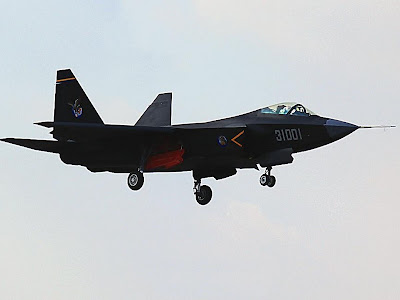Chinese
media reports Quoting Chinese military commentator Lei Ze mentioned how
emergence of the Chinese fifth generation J-31 fighter jet will make it
difficult for the US to export its F-35 fighters , he also said that
Currently, the only fifth generation fighter available for sale is the
F-35 by the US. The J-31 will offer an alternative for non-traditional
allies of the US.”
Indian
Defence analysts Vinayak shetty thinks otherwise and says that it is
unlikely that J-31 will affect export sale of F-35, “Many countries are
firmly behind F-35 Project, even when Prices have surged upwards
recently but it is unlikely any of the current customers will even
consider buying Chinese J-31 even if aircraft hits production now” .
While J-31 is still in testing phase and good 7 to 8 years before enters
production, while F-35 is all set to enter fully fledged Mass
production soon.
 |
While
analysts say the Pakistan Air Force (PAF) might be one of the earliest
customers of the fighter aircraft, but Vinayak shetty believes it will
not be easy for PAF to procure these fighters, PAF are already
struggling to buy hand full of J-10 fighters for last few years, even
with Soft Loan offer provided by Chinese. PAF on other hand in past were
always reluctant to operate twin engine fighter aircraft of medium
capability size due to higher operating cost involved.
With
No 5th generation fighter aircraft Project coming out of Europe many of
these countries will be F-35 operators, and Russian Pak-Fa will capture
export orders from traditional Sukhoi 30 / Mig operators in Asia.
Traditional Chinese fighter aircraft market (Africa / Asian) countries
will struggle to operate 5th generation fighter aircraft, so it will be
very difficult for Chinese to push sales in their traditional market and
difficult to break into American traditional partners, unless sale is
bogged down by Us Export restrictions.
Vinayak
shetty also have raised concern about a potential arms race in Asia due
to emergence of Chinese J-31, many countries that are neighbours of
China and have some unsolved issues with them, might now consider buying
expensive F-35 or Pak-fa actually boosting their sales in return.
Currently
many countries are also working on their own 5th generation fighter
aircraft projects other than Russian, Us and China. India is working on
Advanced Medium Combat Aircraft, Japanese on Mitsubishi ATD-X , Turkey
on TFX and Russia again on single engine cheaper stealth fighter
aircraft based on Mikoyan LMFS , which all might actually eat into J-31
export orders .
















































